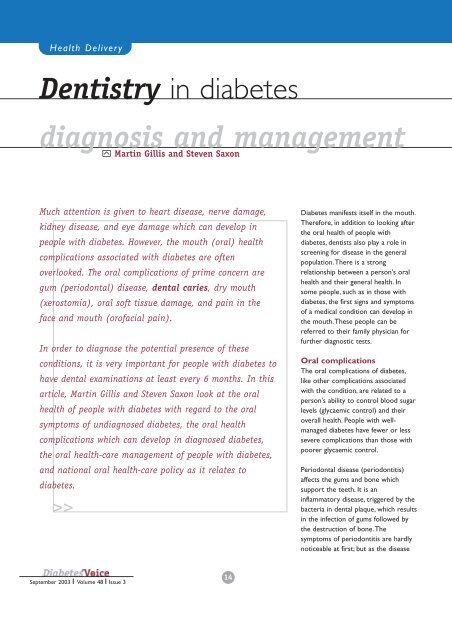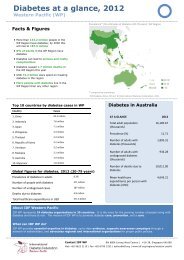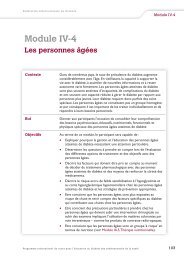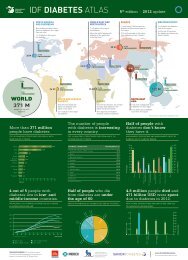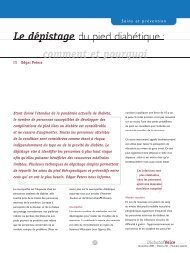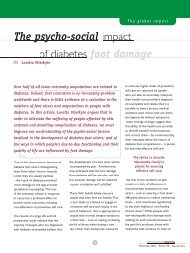Dentistry in diabetes diagnosis and management
Dentistry in diabetes diagnosis and management
Dentistry in diabetes diagnosis and management
You also want an ePaper? Increase the reach of your titles
YUMPU automatically turns print PDFs into web optimized ePapers that Google loves.
Health Delivery<br />
<strong>Dentistry</strong> <strong>in</strong> <strong>diabetes</strong><br />
<strong>diagnosis</strong> <strong>and</strong> <strong>management</strong><br />
Mart<strong>in</strong> Gillis <strong>and</strong> Steven Saxon<br />
Much attention is given to heart disease, nerve damage,<br />
kidney disease, <strong>and</strong> eye damage which can develop <strong>in</strong><br />
people with <strong>diabetes</strong>. However, the mouth (oral) health<br />
complications associated with <strong>diabetes</strong> are often<br />
overlooked. The oral complications of prime concern are<br />
gum (periodontal) disease, dental caries, dry mouth<br />
(xerostomia), oral soft tissue damage, <strong>and</strong> pa<strong>in</strong> <strong>in</strong> the<br />
face <strong>and</strong> mouth (orofacial pa<strong>in</strong>).<br />
In order to diagnose the potential presence of these<br />
conditions, it is very important for people with <strong>diabetes</strong> to<br />
have dental exam<strong>in</strong>ations at least every 6 months. In this<br />
article, Mart<strong>in</strong> Gillis <strong>and</strong> Steven Saxon look at the oral<br />
health of people with <strong>diabetes</strong> with regard to the oral<br />
symptoms of undiagnosed <strong>diabetes</strong>, the oral health<br />
complications which can develop <strong>in</strong> diagnosed <strong>diabetes</strong>,<br />
the oral health-care <strong>management</strong> of people with <strong>diabetes</strong>,<br />
<strong>and</strong> national oral health-care policy as it relates to<br />
<strong>diabetes</strong>.<br />
>><br />
Diabetes manifests itself <strong>in</strong> the mouth.<br />
Therefore, <strong>in</strong> addition to look<strong>in</strong>g after<br />
the oral health of people with<br />
<strong>diabetes</strong>, dentists also play a role <strong>in</strong><br />
screen<strong>in</strong>g for disease <strong>in</strong> the general<br />
population.There is a strong<br />
relationship between a person's oral<br />
health <strong>and</strong> their general health. In<br />
some people, such as <strong>in</strong> those with<br />
<strong>diabetes</strong>, the first signs <strong>and</strong> symptoms<br />
of a medical condition can develop <strong>in</strong><br />
the mouth.These people can be<br />
referred to their family physician for<br />
further diagnostic tests.<br />
Oral complications<br />
The oral complications of <strong>diabetes</strong>,<br />
like other complications associated<br />
with the condition, are related to a<br />
person's ability to control blood sugar<br />
levels (glycaemic control) <strong>and</strong> their<br />
overall health. People with wellmanaged<br />
<strong>diabetes</strong> have fewer or less<br />
severe complications than those with<br />
poorer glycaemic control.<br />
Periodontal disease (periodontitis)<br />
affects the gums <strong>and</strong> bone which<br />
support the teeth. It is an<br />
<strong>in</strong>flammatory disease, triggered by the<br />
bacteria <strong>in</strong> dental plaque, which results<br />
<strong>in</strong> the <strong>in</strong>fection of gums followed by<br />
the destruction of bone.The<br />
symptoms of periodontitis are hardly<br />
noticeable at first; but as the disease<br />
September 2003 Volume 48 Issue 3<br />
14
Health Delivery<br />
Dental caries is the process of<br />
dem<strong>in</strong>eralization of the tooth<br />
surface caused by bacteria <strong>in</strong><br />
which the enamel is broken<br />
down. With proper early<br />
measures, the process can be<br />
halted <strong>and</strong> even reversed. If<br />
untreated, the dem<strong>in</strong>eralization<br />
weakens the tooth <strong>and</strong> may lead<br />
to fracture.<br />
The temporom<strong>and</strong>ibular jo<strong>in</strong>t<br />
allows the lower jaw (m<strong>and</strong>ible)<br />
to move when the mouth opens,<br />
articulat<strong>in</strong>g with the bones at<br />
the side of the skull (temporals).<br />
progresses, symptoms such as<br />
bleed<strong>in</strong>g gums, tooth sensitivity,<br />
recession of gums, bad breath<br />
(halitosis), swollen gums, itchy gums,<br />
<strong>and</strong> loose teeth become apparent.<br />
Scientific studies have shown that<br />
cases of advanced periodontitis are<br />
associated with poorly controlled<br />
<strong>diabetes</strong>. One researcher called it<br />
the sixth complication of <strong>diabetes</strong>. 1<br />
There is a two-way relationship<br />
between <strong>diabetes</strong> <strong>and</strong> periodontitis:<br />
periodontitis can affect <strong>diabetes</strong><br />
control <strong>and</strong> the ability to follow a<br />
proper diet, while poor <strong>diabetes</strong><br />
control can negatively affect the<br />
outcome of treatment for<br />
periodontal disease. A healthy<br />
treatment outcome relies on both<br />
good oral health <strong>and</strong> good <strong>diabetes</strong><br />
<strong>management</strong>.<br />
Dental caries is an oral disease<br />
which affects everybody, but<br />
especially those who have <strong>diabetes</strong>.<br />
This is ma<strong>in</strong>ly due to higher sugar<br />
(glucose) levels <strong>in</strong> the saliva<br />
surround<strong>in</strong>g the teeth.<br />
( )<br />
Gum disease has<br />
been called the<br />
sixth complication<br />
of <strong>diabetes</strong>.<br />
Oral soft tissue damage <strong>in</strong>cludes<br />
fungal <strong>in</strong>fections (c<strong>and</strong>idiasis),<br />
ulcers, denture-sore mouth, <strong>and</strong><br />
changes <strong>in</strong> the tongue (such as<br />
chronic fissured tongue).The<br />
development of these conditions is<br />
due to a dry mouth, delayed wound<br />
heal<strong>in</strong>g <strong>and</strong> altered immune <strong>and</strong><br />
<strong>in</strong>flammatory responses.<br />
Xerostomia, or dry mouth, occurs <strong>in</strong><br />
people with poor <strong>diabetes</strong> control. It<br />
is due to decreased salivary flow<br />
rates, alterations <strong>in</strong> saliva<br />
composition <strong>and</strong> an <strong>in</strong>crease <strong>in</strong><br />
salivary glucose levels. Medications<br />
<strong>and</strong> nerve damage (neuropathies) may<br />
further complicate the xerostomia.<br />
Oral neuropathies can be either<br />
pa<strong>in</strong>ful conditions which are<br />
debilitat<strong>in</strong>g to the person with<br />
<strong>diabetes</strong>, or non-pa<strong>in</strong>ful conditions<br />
which alter taste <strong>and</strong> function.<br />
Examples of oral neuropathies are:<br />
• burn<strong>in</strong>g mouth syndrome<br />
• burn<strong>in</strong>g tongue<br />
• temporom<strong>and</strong>ibular jo<strong>in</strong>t<br />
dysfunction (TMD)<br />
• depapillation <strong>and</strong> fissur<strong>in</strong>g of the<br />
tongue.<br />
<strong>Dentistry</strong> <strong>and</strong> <strong>diabetes</strong><br />
<strong>diagnosis</strong><br />
There is a relationship between oral<br />
disease <strong>and</strong> those affect<strong>in</strong>g the whole<br />
body (systemic). Diabetes is a<br />
condition which reflects this<br />
relationship. A person with<br />
undiagnosed <strong>diabetes</strong> who visits the<br />
dentist for a check-up will show oral<br />
symptoms which could alert the >><br />
15<br />
September 2003 Volume 48 Issue 3
Health Delivery<br />
dentist of this undiagnosed<br />
condition. People who previously<br />
had unremarkable check-ups may<br />
have dry mouth, periodontitis, soft<br />
tissue damage <strong>and</strong> dental caries. At<br />
the same time, the person with<br />
<strong>diabetes</strong> may talk about weight<br />
changes, blurred vision, lethargy,<br />
changes <strong>in</strong> mood, <strong>and</strong> frequent<br />
trips to the toilet.<br />
These symptoms would alert the<br />
dentist to refer this person with<br />
<strong>diabetes</strong> to their family physician<br />
for diagnostic blood work to test<br />
for <strong>diabetes</strong>.The <strong>diagnosis</strong> <strong>and</strong><br />
treatment of <strong>diabetes</strong> is not with<strong>in</strong><br />
the scope of practice of the<br />
general dentist. It is, however,<br />
with<strong>in</strong> the dentist's scope of<br />
practice to be highly vigilant with<br />
this aspect of care.This applies not<br />
only to <strong>diabetes</strong>, but to all<br />
systemic conditions that <strong>in</strong>fluence<br />
oral health.<br />
(<br />
In a check-up,<br />
)<br />
a person with<br />
undiagnosed<br />
<strong>diabetes</strong> may<br />
show oral<br />
symptoms which<br />
could alert the<br />
dentist of the<br />
condition.<br />
Collaborative efforts<br />
In February 2003, the Nova<br />
Scotia Dental Association<br />
(NSDA), the Canadian Diabetes<br />
Association (CDA)-Nova Scotia<br />
Division, <strong>and</strong> Dalhousie University<br />
held a <strong>diabetes</strong> oral consultation<br />
cl<strong>in</strong>ic.The cl<strong>in</strong>ic was available to<br />
people with <strong>diabetes</strong> for<br />
consultations with dentists to<br />
assess their oral health status with<br />
respect to the oral complications<br />
of <strong>diabetes</strong>.The goals of the cl<strong>in</strong>ic<br />
were to:<br />
• <strong>in</strong>crease public awareness of the<br />
oral complications of <strong>diabetes</strong><br />
• educate people with <strong>diabetes</strong><br />
about the importance of good<br />
oral health <strong>and</strong> the necessity of<br />
regular visits to the dentist<br />
• uncover the barriers which<br />
people with <strong>diabetes</strong> face <strong>in</strong><br />
seek<strong>in</strong>g oral health care.<br />
In 2003, there was also a poster<br />
campaign which was co-sponsored<br />
by NSDA <strong>and</strong> CDA. More than<br />
2000 posters were distributed to<br />
dental <strong>and</strong> medical practices, <strong>and</strong><br />
<strong>diabetes</strong> care centres throughout<br />
Nova Scotia.These posters are<br />
designed to communicate to<br />
people with <strong>diabetes</strong> the<br />
importance of good oral health<br />
care, <strong>and</strong> the importance of<br />
keep<strong>in</strong>g rout<strong>in</strong>e dental<br />
appo<strong>in</strong>tments.<br />
Posters are designed to<br />
communicate to people with<br />
<strong>diabetes</strong> the importance of<br />
good oral health care.<br />
September 2003 Volume 48 Issue 3<br />
16
Health Delivery<br />
National oral health-care<br />
policy on <strong>diabetes</strong><br />
The US <strong>and</strong> a number of European<br />
countries have developed oral<br />
health-care policies. Canada is <strong>in</strong> the<br />
process of develop<strong>in</strong>g such a<br />
policy. A national oral health-care<br />
policy essentially <strong>in</strong>volves the:<br />
• collection of current<br />
epidemiological data<br />
• identification of a problem area<br />
based on this data<br />
• establishment of a measurable<br />
goal to improve the identified<br />
problem<br />
• development of action<br />
programmes to reach this goal.<br />
An example is the US 'Healthy<br />
People 2010' health-care strategy.<br />
The document encompasses all<br />
aspects of health care, <strong>in</strong>clud<strong>in</strong>g<br />
oral health <strong>and</strong> <strong>diabetes</strong>. One goal<br />
of the strategy is to <strong>in</strong>crease the<br />
percentage of people with <strong>diabetes</strong><br />
hav<strong>in</strong>g at least one annual dental<br />
check up from the current 58% to<br />
75% by the year 2010. 2<br />
( )<br />
The f<strong>in</strong>ancial <strong>and</strong><br />
social costs of oral<br />
disease are high.<br />
Action programmes need to be<br />
developed <strong>in</strong> order to reach this<br />
<strong>and</strong> other oral health-care goals.<br />
A second document, 'A national call<br />
to action to promote oral health',<br />
prepared by the office of the US<br />
Surgeon General, outl<strong>in</strong>es the<br />
objectives necessary to atta<strong>in</strong> these<br />
goals.These objectives apply to oral<br />
health <strong>and</strong> <strong>diabetes</strong> through the:<br />
• recognition of oral health care as<br />
an accepted component of<br />
<strong>diabetes</strong> <strong>management</strong><br />
• accumulation of scientific<br />
<strong>in</strong>formation to develop an<br />
evidence base <strong>in</strong> order to<br />
improve the oral health of people<br />
with <strong>diabetes</strong><br />
• removal of the barriers to care<br />
faced by people with <strong>diabetes</strong><br />
through the development of oral<br />
health-care programmes. 3<br />
The burden of oral disease restricts<br />
activities <strong>in</strong> school, <strong>in</strong> the workplace,<br />
at home, <strong>and</strong> impacts negatively<br />
upon a person's quality of life.The<br />
f<strong>in</strong>ancial <strong>and</strong> social costs of oral<br />
disease are high. A national oral<br />
health-care policy is designed to<br />
help society deal with oral disease.<br />
It also deals with the relationship<br />
between oral disease <strong>and</strong> systemic<br />
conditions.The relationship between<br />
oral health <strong>and</strong> systemic health is<br />
well illustrated with <strong>diabetes</strong>.<br />
Scientific study, oral health-care<br />
programmes, <strong>and</strong> collaborative<br />
efforts between dental associations,<br />
<strong>diabetes</strong> organizations, <strong>and</strong> the<br />
private sector can create a template<br />
which is <strong>in</strong>tegral for deal<strong>in</strong>g with<br />
oral health-care issues.Templates of<br />
this k<strong>in</strong>d provide a foundation for<br />
the health-care policy makers <strong>and</strong><br />
educators to give health-care<br />
providers the resources necessary<br />
to improve the public's well be<strong>in</strong>g.<br />
Mart<strong>in</strong> Gillis <strong>and</strong> Steven<br />
Saxon<br />
Mart<strong>in</strong> Gillis is a family dentist <strong>in</strong><br />
Liverpool, Nova Scotia, Canada. He is<br />
a member of the Nova Scotia Dental<br />
Association <strong>and</strong> a cl<strong>in</strong>ic <strong>in</strong>structor at<br />
Dalhousie University Dental School. He<br />
has had Type 1 <strong>diabetes</strong> for 15 years.<br />
Steven Saxon is a family dentist <strong>in</strong><br />
Sydney, Nova Scotia, Canada. He is a<br />
member of the Nova Scotia Dental<br />
Association <strong>and</strong> Vice President of the<br />
Cape Breton Branch of the Nova Scotia<br />
Diabetes Association. He has had<br />
Type 1 <strong>diabetes</strong> for 30 years.<br />
References<br />
1. Loe H. Periodontal disease: the<br />
sixth complication of <strong>diabetes</strong><br />
mellitus. Diabetes Care 1993; 16:<br />
329-334.<br />
2. US Department of Health <strong>and</strong><br />
Human Services. Healthy People 2010.<br />
2nd ed.2 vols. Wash<strong>in</strong>gton, DC: US<br />
Government Pr<strong>in</strong>t<strong>in</strong>g Office, November<br />
2000.<br />
3. US Department of Health <strong>and</strong><br />
Human Services. National call to<br />
action to promote oral health.<br />
Rockville, MD: US Department of<br />
Health <strong>and</strong> Human Services, Public<br />
Health Service, National Institutes of<br />
Health, National Institute of Dental<br />
<strong>and</strong> Craniofacial Research. NIH<br />
Publication No. 03-5303, Spr<strong>in</strong>g 2003.<br />
17<br />
September 2003 Volume 48 Issue 3


